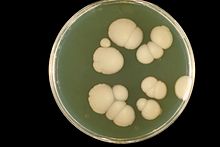



Sabouraud agar or Sabouraud dextrose agar (SDA) is a type of agar growth medium containing peptones. It is used to cultivate dermatophytes and other types of fungi, and can also grow filamentous bacteria such as Nocardia. It has utility for research and clinical care.
It was created by, and is named after, Raymond Sabouraud in 1892. In 1977 the formulation was adjusted by Chester W. Emmons when the pH level was brought closer to the neutral range and the dextrose concentration lowered to support the growth of other microorganisms. The acidic pH (5.6) of traditional Sabouraud agar inhibits bacterial growth. Peptones are complex digests and can be a source of variability in Sabouraud agar.
Typical composition
Sabouraud agar is commercially available and typically contains:
Medical use
Clinical laboratories can use this growth medium to diagnose and further speciate fungal infections, allowing medical professionals to provide appropriate treatment with antifungal medications. Histoplasma and other fungal causes of atypical pneumonia can be grown on this medium. Sabouraud agar used in combination with additional media, such as Inhibitory Mold Agar (IMA), improves identification of fungal clinical isolates.
References
- "Omnipresence of Microorganisms in the Environment". Waksman Foundation For Microbiology. Archived from the original on 2008-10-06. Retrieved 2008-10-24.
- Sandven P, Lassen J (November 1999). "Importance of selective media for recovery of yeasts from clinical specimens". Journal of Clinical Microbiology. 37 (11): 3731–3732. doi:10.1128/JCM.37.11.3731-3732.1999. PMC 85742. PMID 10523586.
- Guinea J, Peláez T, Alcalá L, Bouza E (December 2005). "Evaluation of Czapeck agar and Sabouraud dextrose agar for the culture of airborne Aspergillus conidia". Diagnostic Microbiology and Infectious Disease. 53 (4): 333–334. doi:10.1016/j.diagmicrobio.2005.07.002. PMID 16263232.
- "About Modified Sabouraud Agar" (PDF). www.bd.com. Archived from the original (PDF) on 19 April 2009.
- Hare JM (9 December 2012). "15. Sabouraud agar for fungal growth". In Gupta VK, Tuohy MG, Ayyachamy M, Turner KM, O'Donovan A (eds.). Laboratory Protocols in Fungal Biology: Current Methods in Fungal Biology. Springer. p. 212. ISBN 978-1-4614-2355-3.
- Odds FC (January 1991). "Sabouraud('s) agar". Journal of Medical and Veterinary Mycology. 29 (6): 355–359. doi:10.1080/02681219180000581. PMID 1815027.
- "Recipes". University of Sydney. 2004. Archived from the original on 14 December 2012.
- Scognamiglio T, Zinchuk R, Gumpeni P, Larone DH (May 2010). "Comparison of inhibitory mold agar to Sabouraud dextrose agar as a primary medium for isolation of fungi". Journal of Clinical Microbiology. 48 (5): 1924–1925. doi:10.1128/JCM.01814-09. PMC 2863941. PMID 20220162.
| Growth media / agar plates | |||||||||||||||
|---|---|---|---|---|---|---|---|---|---|---|---|---|---|---|---|
| Selective media |
| ||||||||||||||
| Differential media | |||||||||||||||
| Fungal media | |||||||||||||||
| Nonselective media | |||||||||||||||
| Other/ungrouped media | |||||||||||||||
This microbiology-related article is a stub. You can help Misplaced Pages by expanding it. |